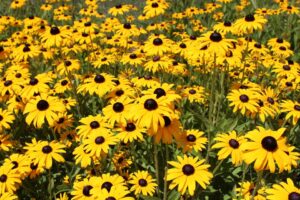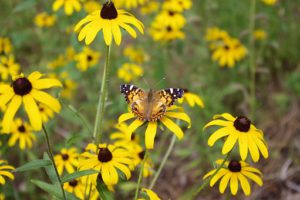How to Grow and Care for Black Eyed-Susan Flowers

A splash of yellow here and there in a garden setting can really brighten up a dull area, while there are so many flowering plants that produce gorgeous yellow flower blooms there is a plant that is popular among garden lovers and has made a name for its self that is the Black-Eyed Susan Flowers.
This charming perennial gets its name in part from its black center or eye and attracts butterflies, bees, and birds creating a garden wonder when planted in masses. Black-eyed Susan produces a golden to yellowish flower that is so beautiful, this garden beauty is classified as a wild flowering plant and can be found growing in open fields. The black-eyed Susan is a member of the sunflower family (Asteraceae) and is native to North and Eastern America, this perennial is a drought-tolerant plant that can withstand extreme heat blooming mostly during the summer months.
It’s believed that the black-eyed Susan was used as a medical herb during the early days of its discovery. This garden beauty will make the perfect plant for your summer garden. For more on how to care for black-eyed Susan that has so much to offer let’s take a closer look.
The planting location
You can either purchase black-eyed Susan as a bedding plant during springtime or start them from seeds indoors at the beginning of spring before the last frost or sow them directly into the ground as the weather warms up. Black-eyed Susan loves sunny areas though they can thrive in partial sun and grows to about 3 ft or taller with a spread of 12 to 18 inches.
Type soil
Black-eyed Susan can grow in a variety of soils and prefers a neutral soil ph.
Watering methods
Black-eyed Susan is drought tolerant so care should be taken when watering, water only when the topsoil feels dry because overwatering can lead to root rot.
Fertilizing methods
Twice a year is ideal when fertilizing black-eyed Susan, a general granular all-purpose slow-release fertilizer is ideal.
Garden pests of the black-eyed Susan
Garden pests of the black-eyed Susan are as followed.

- Snails and Slugs
- Aphids
- Tarnish plant bug
- Thrips
- Leafhoppers
- Lace bugs
- Cucumber beetles
Slugs and Snails
Slugs and Snails cause damage by eating plant parts, these pests will leave a slimy trail behind, to get rid of slugs and snails handpicking and throwing them into a bucket of soapy water or the use of snail baits will bring control.
Aphids
Aphids are pared-shaped insects that can be either brown, black, green, yellow, or even red. Aphids are sucking insects that will cause flower drops, their excrement which is a sugary substance will cause black mold to form giving garden plants a sickly appearance. Insecticidal soap will bring control. Before applying read and follow the manufacturer’s directions for the best results.
Tarnish plant bug
These bugs attack flower buds and cause the distorting of the leaves. The use of insecticidal soap will bring control.
Thrips
Thrips are tiny insects with two pairs of fringed wings and a slender body. Thrips are sucking insects that will extract the plant’s fluids causing pants to become twisted and distorted when heavily infested. Plants will lose their vigor becoming pale, the use of neem oil, insecticidal soap, or releasing predatory insects such as ladybugs and lace wigs will bring control.
Leafhoppers
Leafhoppers have wedge-shaped bodies that are slender, damage includes the edges of the leaves taking on a burnt appearance with stippling and death. These garden insect pests will overwinter in the leaf litter therefore keeping the flower bed clean of debris is a must. Leafhoppers also cause aster yellow.
Aster yellow causes deformed leaves and flowers, there is no cure for this disease. The use of Sevin along with the removal of infected plant parts and properly disposing of will bring control.
Lace bugs
Lace bugs are tiny insects that have intricate veining wings that resemble lace. Young lace bugs are nymphs that are black, both the adult and the nymphs can be found congregating on the underside of the plant’s leaves. These garden insect pests suck the plant’s sap which causes yellowing of the leaves along with discoloration on the underside. Pesticides such as insecticidal soap, horticultural oil, or marathon will bring control.
Cucumber beetles
These beetles are greenish-yellow with black spots on their wings, cucumber beetles feed on flowers, new growth, and pollen. Because they overwinter in the leaf litter ensure that the flower bed is free of debris. Cucumber beetles can be controlled with beneficial nematodes, predatory insects, or handpicking.
Diseases of the black-eyed Susan
Diseases to keep an eye out for.
- Powdery mildew
- Rust
- Leaf spot
- Smut
Powdery Mildew
Powdery mildew is brought on by warm conditions along with poor air circulation. The fungus that causes this disease will weaken the plant’s younger leaves followed by yellowing. A powdery white substance will cover parts of the plant’s leaves, with a hand pruner remove infected plant parts and properly dispose of them. The use of a fungicide that is labeled for this disease will bring control. Before using fungicides read and follow the manufacturer’s directions for the best results.
Rust
Rust is a fungal disease that is brought on by moist mild conditions, this disease is spread by spores that are transferred from an infected plant to healthy plants. These spores are spread by the wind or water, signs of this disease include yellow to orange spots that appear on the leaves’ underside,
Yellow or white spots may appear on the upper leaves, spores may appear in infected spots, and orange to reddish blisters or swellings will appear on the leaves’ underside, these swellings are called pustules. The leaves become distorted followed by leaf drops. This disease is difficult to control, to combat avoid splashing water on plants by watering from the soil level.
Remove all infected parts and properly dispose of them, keep your plants free of debris by keeping the plant clean, and make sure that adequate spacing is given for proper air circulation. Early in the season dust your plants with sulfur to discourage this disease, the use of a fungicide that’s labeled for rust will offer help.
Leaf spot
Leaf spots can be brought on by fungus or bacteria, signs show up as spots on the leaves that are of various sizes and colors depending on the plant that’s infected. Spots are most often brown but will appear black or tan with concentric rings or dark margins that appear, black dots may appear in the infected spot known as fungal bodies.
If these conditions are allowed to persist the spots will enlarge to form blotches, followed by yellowing of the leaves and defoliation. Wet conditions cause spores to splash on the leaves also windy conditions will encourage this disease. To avoid leaf spot disease water plants from the soil level.
Remove infected plant parts and debris properly disposed of, and give the plant the right spacing for proper air circulation along with thinning. Avoid over-fertilizing and keep the plant’s leaves as dry as possible. The use of a fungicide will offer help. Before using fungicides read and follow the manufacturer’s directions for the best results.
Smut
Smut causes yellow circular spots to form on leaves, as the disease progress these spots will dry and brown. The use of a fungicide that contains mancozeb will bring this disease under control. Read and follow the manufacturer’s directions for the best results. Keeping your garden bed free of debris, decaying matter, and weeds will help in keeping smut at bay.
Growing black-eyed Susan from containers
When growing black-eyed Susan from a container ensure there are drain holes for water drainage, fill about one-third of the container with gravel which will also aid with good drainage. Fill the container with good potting soil, followed by adding your seeds. Press seeds about 1/4 inch into the soil and 8 inches apart.
Moisten the soil, don’t allow the soil to dry out completely. In about a week or two, your seeds will germinate. Followed instructions as stated above when it comes to maintenance of your black-eyed Susan.
Deadheading black-eyed Susan
Deadheading is a must to keep your black-eyed Susan growing healthy, the ideal time to deadhead black-eyed Susan is when it is about to set seed. If you allow your black-eyed Susan to set seed it will stop producing buds and flower bloom putting all of its energy into seed production. As you continue to deadhead will prevent seeds from forming allowing the flowers to produce new buds.
Grasp the faded flower gently beneath the flower head, at the base of the stem look for the topmost set of leaves, above the stem joint make 1/4 cut through the stem removing the spent flower. Birds are attracted to these plants because they use the seeds for food, especially during the winter months.
The final word on black-eyed Susan
Black-eyed Susan is a great summer plant that will do well in your summer garden, these garden beauties are not fussy and will do the job for you. Their ability to thrive under extreme heat along with having a high tolerance for drought and attracting wildlife and other pollinators makes this plant a must with its golden to yellow flower. Invest in black-eyed Susan and watch as this garden plant goes to work for you.
About the author
Norman loves being in the garden, both at home and for his job....
he is 'Natures Little helper' being outdoors, growing his vegetables and flowers from an early age.
Now having spent over 22 years in the profession he want to give some of his knowledge to others...
his vast array of hints and tips you will find scattered over this site will help you no end growing plants in your garden.
